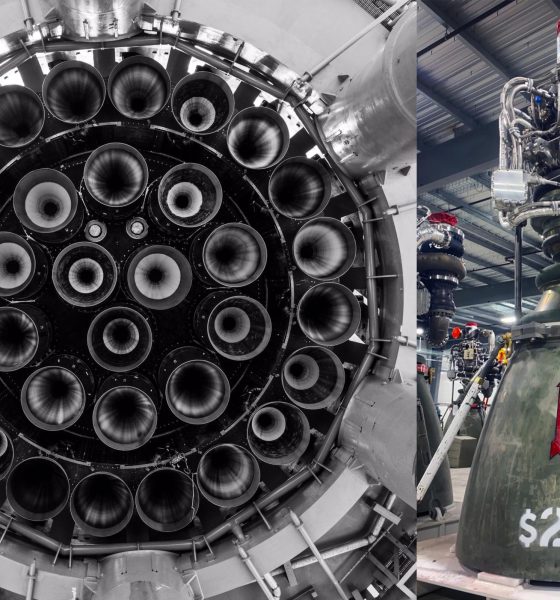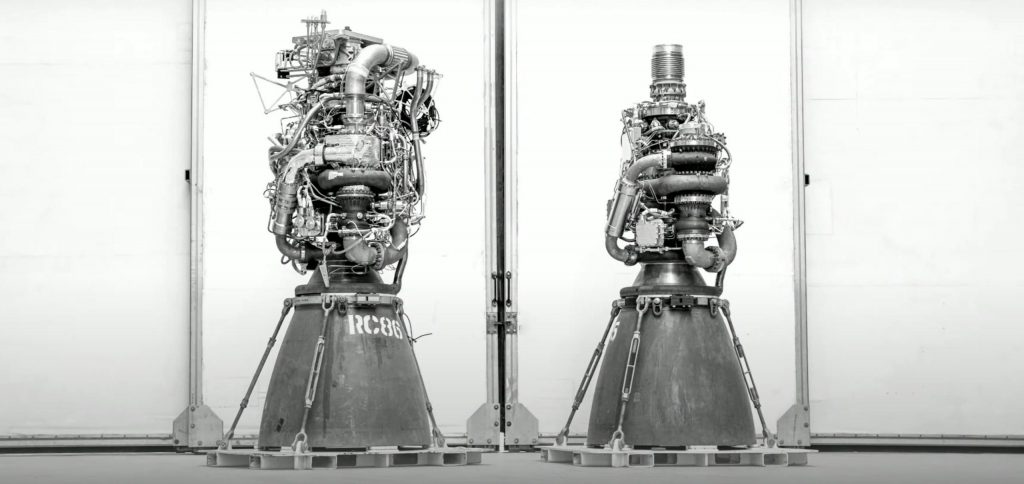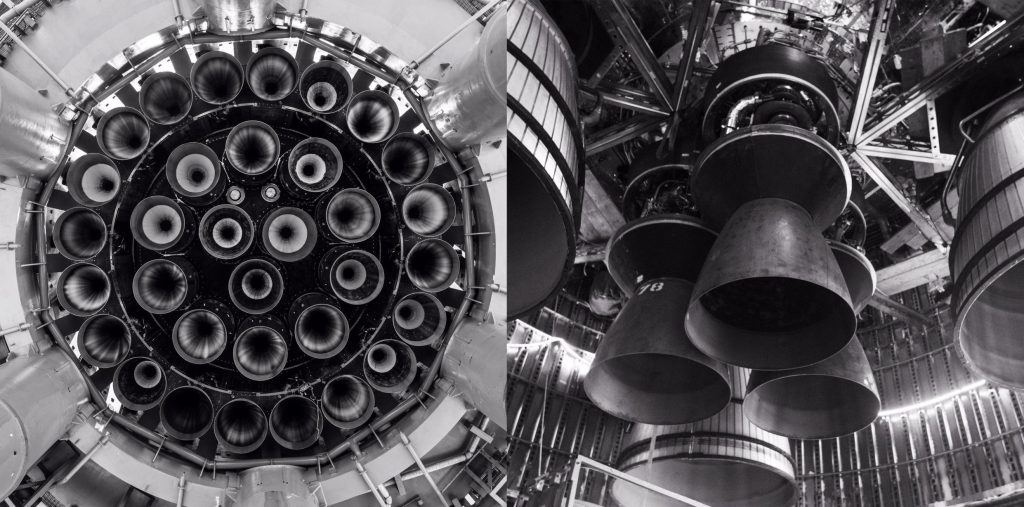

News
SpaceX ships Starship’s 200th upgraded Raptor engine
A day after revealing the completion of the 200th Falcon upper stage and Merlin Vacuum engine, SpaceX has announced that it also recently finished building Starship’s 200th upgraded Raptor engine.
Starship – and Raptor, by extension – has yet to reach orbit and is likely years away from scratching the surface of the established success and reliability of the Falcon upper stage and MVac. But compared to MVac, Raptor is more complex, more efficient, more than twice as powerful, experiences far more stress, and is three times younger.
And Raptor 2 isn’t the first version of the engine. Before SpaceX shipped its first Raptor 2 prototype, it manufactured 100 Raptor 1 engines between the start of full-scale testing in February 2018 and July 2021. By late 2021 or early 2022, when Raptor 2 took over, the total number of Raptor 1 engines produced likely reached somewhere between 125 and 150 – impressive but pale in comparison to SpaceX’s Raptor 2 ambitions.
From the start, Raptor 2’s purpose was to make future Raptors easier, faster, and cheaper to manufacture. The ultimate goal is to eventually reduce the cost of Raptor 2 production to $1000 per ton of thrust, or $230,000 at Raptor 2’s current target of 230 tons (~510,000 lbf) of thrust. As of mid-2019, Musk reported that each early Raptor 1 prototype cost “more” than $2 million for what would turn out to be 185 tons of thrust (~$11,000 per ton). It’s not clear if that ever appreciably changed.
In response, SpaceX strived to make Raptor 2 simpler wherever possible, removing a large part of the maze of primary, secondary, and tertiary plumbing. In 2022, CEO Elon Musk confirmed that SpaceX had even removed a complex torch igniter system for Raptor 2’s main combustion chamber. All that simplification made Raptor 2 much easier to build in theory, and SpaceX’s production figures have more than confirmed that theory. Despite those simplifications, SpaceX was also able to boost Raptor 2’s thrust by 25% by sacrificing just 1% of Raptor 1’s efficiency.

Beginning with its first delivery in February 2018, SpaceX produced the first 100 Raptor 1 engines in about 36 months. In the first 11 to 12 months of Raptor 2 production, SpaceX has delivered 200 engines. That translates to at least six times the average throughput, but the true figure is even higher. In June 2019, Musk stated that SpaceX was “aiming [to build a Raptor] engine every 12 hours by end of year.” As is usually the case, that progress took far longer to realize. But in October 2022, a senior NASA Artemis Program official revealed that SpaceX recently achieved sustained production of one Raptor 2 engine per day for a full week.
Such a high rate – likely making Raptor one of the fastest-produced orbital-class rocket engines in history – is required because SpaceX’s next-generation Starship rocket needs a huge amount of engines. The Starship upper stage currently requires three sea-level-optimized Raptors and three vacuum-optimized Raptors, and SpaceX has plans to increase that to nine engines total. Starship’s Super Heavy booster is powered by 33 sea-level Raptors.

Orbital-class versions of Starship and Super Heavy have never flown, let alone demonstrated successful recovery or reuse, so SpaceX has to operate under the assumption that every orbital test flight will consume 39 Raptors. Even after the reuse of Super Heavy boosters or Starships becomes viable, taking significant strain off of Raptor demand, SpaceX wants to manufacture a fleet of hundreds or even thousands of Starships and a similarly massive number of boosters. To outfit that massive fleet, SpaceX would have to mass-produce orbital-class Raptor engines at a scale that’s never been attempted.
But it will likely be years – if not a decade or longer – before SpaceX is in a position to attempt to create that mega-fleet. If the Raptor 2 engines SpaceX is already building are modestly reliable and reusable, and it doesn’t take more than 5-10 orbital test flights to begin reusing Starships and Super Heavy boosters, a production rate of one engine per day is arguably good enough to support the next few years of realistic engine demand.
SpaceX’s first orbital Starship launch attempt could occur as early as December 2022, although Q1 2023 is more likely. SpaceX currently has permission for up to five orbital Starship launches per year out of its Starbase, Texas facilities and will likely try to take full advantage of that with several back-to-back test flights in a period of 6-12 months.

Elon Musk
Elon Musk and Tesla AI Director share insights after empty driver seat Robotaxi rides
The executives’ unoccupied tests hint at the rapid progress of Tesla’s unsupervised Robotaxi efforts.

Tesla CEO Elon Musk and AI Director Ashok Elluswamy celebrated Christmas Eve by sharing personal experiences with Robotaxi vehicles that had no safety monitor or occupant in the driver’s seat. Musk described the system’s “perfect driving” around Austin, while Elluswamy posted video from the back seat, calling it “an amazing experience.”
The executives’ unoccupied tests hint at the rapid progress of Tesla’s unsupervised Robotaxi efforts.
Elon and Ashok’s firsthand Robotaxi insights
Prior to Musk and the Tesla AI Director’s posts, sightings of unmanned Teslas navigating public roads were widely shared on social media. One such vehicle was spotted in Austin, Texas, which Elon Musk acknowleged by stating that “Testing is underway with no occupants in the car.”
Based on his Christmas Eve post, Musk seemed to have tested an unmanned Tesla himself. “A Tesla with no safety monitor in the car and me sitting in the passenger seat took me all around Austin on Sunday with perfect driving,” Musk wrote in his post.
Elluswamy responded with a 2-minute video showing himself in the rear of an unmanned Tesla. The video featured the vehicle’s empty front seats, as well as its smooth handling through real-world traffic. He captioned his video with the words, “It’s an amazing experience!”
Towards Unsupervised operations
During an xAI Hackathon earlier this month, Elon Musk mentioned that Tesla owed be removing Safety Monitors from its Robotaxis in Austin in just three weeks. “Unsupervised is pretty much solved at this point. So there will be Tesla Robotaxis operating in Austin with no one in them. Not even anyone in the passenger seat in about three weeks,” he said. Musk echoed similar estimates at the 2025 Annual Shareholder Meeting and the Q3 2025 earnings call.
Considering the insights that were posted Musk and Elluswamy, it does appear that Tesla is working hard towards operating its Robotaxis with no safety monitors. This is quite impressive considering that the service was launched just earlier this year.
Elon Musk
Starlink passes 9 million active customers just weeks after hitting 8 million
The milestone highlights the accelerating growth of Starlink, which has now been adding over 20,000 new users per day.

SpaceX’s Starlink satellite internet service has continued its rapid global expansion, surpassing 9 million active customers just weeks after crossing the 8 million mark.
The milestone highlights the accelerating growth of Starlink, which has now been adding over 20,000 new users per day.
9 million customers
In a post on X, SpaceX stated that Starlink now serves over 9 million active users across 155 countries, territories, and markets. The company reached 8 million customers in early November, meaning it added roughly 1 million subscribers in under seven weeks, or about 21,275 new users on average per day.
“Starlink is connecting more than 9M active customers with high-speed internet across 155 countries, territories, and many other markets,” Starlink wrote in a post on its official X account. SpaceX President Gwynne Shotwell also celebrated the milestone on X. “A huge thank you to all of our customers and congrats to the Starlink team for such an incredible product,” she wrote.
That growth rate reflects both rising demand for broadband in underserved regions and Starlink’s expanding satellite constellation, which now includes more than 9,000 low-Earth-orbit satellites designed to deliver high-speed, low-latency internet worldwide.
Starlink’s momentum
Starlink’s momentum has been building up. SpaceX reported 4.6 million Starlink customers in December 2024, followed by 7 million by August 2025, and 8 million customers in November. Independent data also suggests Starlink usage is rising sharply, with Cloudflare reporting that global web traffic from Starlink users more than doubled in 2025, as noted in an Insider report.
Starlink’s momentum is increasingly tied to SpaceX’s broader financial outlook. Elon Musk has said the satellite network is “by far” the company’s largest revenue driver, and reports suggest SpaceX may be positioning itself for an initial public offering as soon as next year, with valuations estimated as high as $1.5 trillion. Musk has also suggested in the past that Starlink could have its own IPO in the future.
News
NVIDIA Director of Robotics: Tesla FSD v14 is the first AI to pass the “Physical Turing Test”
After testing FSD v14, Fan stated that his experience with FSD felt magical at first, but it soon started to feel like a routine.

NVIDIA Director of Robotics Jim Fan has praised Tesla’s Full Self-Driving (Supervised) v14 as the first AI to pass what he described as a “Physical Turing Test.”
After testing FSD v14, Fan stated that his experience with FSD felt magical at first, but it soon started to feel like a routine. And just like smartphones today, removing it now would “actively hurt.”
Jim Fan’s hands-on FSD v14 impressions
Fan, a leading researcher in embodied AI who is currently solving Physical AI at NVIDIA and spearheading the company’s Project GR00T initiative, noted that he actually was late to the Tesla game. He was, however, one of the first to try out FSD v14.
“I was very late to own a Tesla but among the earliest to try out FSD v14. It’s perhaps the first time I experience an AI that passes the Physical Turing Test: after a long day at work, you press a button, lay back, and couldn’t tell if a neural net or a human drove you home,” Fan wrote in a post on X.
Fan added: “Despite knowing exactly how robot learning works, I still find it magical watching the steering wheel turn by itself. First it feels surreal, next it becomes routine. Then, like the smartphone, taking it away actively hurts. This is how humanity gets rewired and glued to god-like technologies.”
The Physical Turing Test
The original Turing Test was conceived by Alan Turing in 1950, and it was aimed at determining if a machine could exhibit behavior that is equivalent to or indistinguishable from a human. By focusing on text-based conversations, the original Turing Test set a high bar for natural language processing and machine learning.
This test has been passed by today’s large language models. However, the capability to converse in a humanlike manner is a completely different challenge from performing real-world problem-solving or physical interactions. Thus, Fan introduced the Physical Turing Test, which challenges AI systems to demonstrate intelligence through physical actions.
Based on Fan’s comments, Tesla has demonstrated these intelligent physical actions with FSD v14. Elon Musk agreed with the NVIDIA executive, stating in a post on X that with FSD v14, “you can sense the sentience maturing.” Musk also praised Tesla AI, calling it the best “real-world AI” today.








